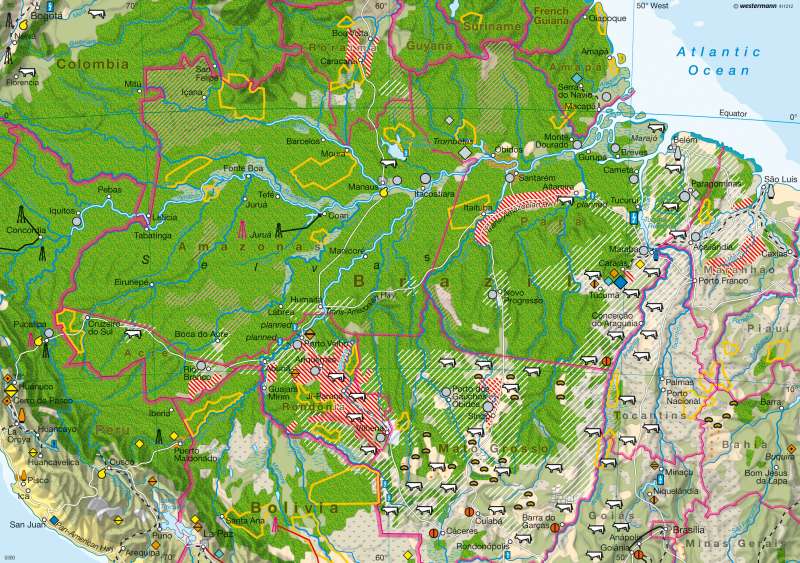Amazonas — Encroachment into the tropical rainforest
South America
978-3-14-100790-9 | Page 150 | Ill. 2

Information
With an area of around 5.8 million km², the Amazon rainforest (Amazonia) is the world's largest area of tropical rain forest. It covers one fifth of the total land area of South America, whereby 75 percent of it is located in Brazil; the other quarter is distributed over the neighbouring countries Bolivia, Columbia, Ecuador and Peru. The Amazon rainforest is home to an extraordinarily rich and diverse flora and fauna and at the same time it is of significant importance to the Earth's ecosystem — in particular the world's climate. Since the 1970s, the region has been threatened by extensive legal and illegal tree clearing, which in recent years has continued unabated despite known ecological risks.The Beginnings of Exploitation
In the southern part of the map detail the tropical rainforest changes into moist savannah. Due to natural and climatic conditions both zones are well suited for agricultural use and have already been considerably altered by anthropogenic intervention.
The economic exploitation of the Amazon rainforest began with the extraction of natural rubber in the second half of the 19th Century. Its destruction however first started in 1970 with the commencement of the construction of a highway through southern Amazonia, the "Trans-Amazonian", which was later expanded through a further network of highways. Funded by the Brazilian government in the 1970s, a "ruropolis" was developed in the state of Pará between Altamira and Itaituba. The aim of this project was to establish a 100-kilometre strip of agricultural land on each side of the Trans-Amazonian. Each settler who participated in the colonisation project was sold 100 hectares of land, a simple wooden house, and tools and seeds on credit with the objective of clearing and cultivating around 50 percent of each respective lot. Similar conditions applied to the two zones immediately adjacent to and behind the small-scale agricultural plots in the Trans-Amazon hinterland. In these areas larger medium-sized enterprises were established.
It was planned to settle around 100,000 families in this manner, but only approx. 7000 participated in the risky undertaking. The project ultimately failed because the number of migrants, who turned their back on Amazonia, soon exceeded the number of immigrants arriving. This failure was partly due to the colonist"s lack of agricultural experience in tropical regions, but also because of organisational shortcomings e.g. inefficient cooperatives and lack of market potential.
The Expansion of Land Clearing
In the following years, despite the failure of this one project, the government continued to support large-scale land clearing at the edge of the Amazon rainforest and along the newly constructed roadways. Agricultural colonists cleared much of the forest in order to claim new land for cultivation or extensive cattle ranching. In recent years the expansion of soybean cultivation, used as concentrated feed for pigs and cattle and increasingly used as an energy feedstock, has played a major role in deforestation; but also the biofuel boom, which requires vegetable biomass for its production, above all sugarcane and soy, both of which thrive in tropical and subtropical conditions.
A further economic reason for deforestation was logging, in particular of mahogany, an extremely durable hardwood, which is widely used in developed countries in the construction of windows, doors and furniture. Over the last decades more than 2000 logging companies, predominantly of foreign origin, have taken part in the exploitation of the tropical rainforests. Even though mahogany is now protected by law, illegal logging is still being practiced on a large-scale.
The third significant factor in the destruction of the tropical and subtropical rainforests has proven to be the region"s extraordinary abundance of mineral resources. Through the discovery and mining of large deposits of iron ore and other significant deposits, for example gold, tin, asbestos, bauxite and natural oil, the encroachments of the rainforest have progressed continuously.
In 2005 and 2006 alone, an area the size of North Rhine Westphalia was cleared in Brazil. As a result of this large-scale deforestation the country will have lost around 13 percent of its natural rainforests by the end of 2006. In 1975 in the state of Mato Grosso around 1 percent of land area was affected by land clearing, this had risen to more than 6 percent in 1980 and today more than half of the original rainforest has been transformed into grazing and farmland. The statistics are similar in the states of Pará, Rondonia and Maranhao. The state of Amazonia and Amapá however still have relatively large areas of unspoiled rainforest.
H. Kremb; Ü: J. Moar, M. Dahl




